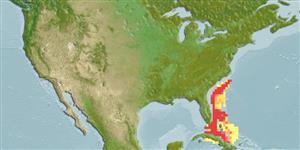Common names from other countries
分类 / Names
俗名 | 同种异名 | Catalog of Fishes(属, 种) | ITIS | CoL | WoRMS | Cloffa
Elasmobranchii
板鳃亚纲 (鲨鱼与 鱼) (sharks and rays) >
Torpediniformes (Electric rays) >
Narcinidae (Numbfishes)
Etymology: Benthobatis: Greek, benthos = depth of the sea + Greek, batis, -idos = a ray (Raja sp.) (Ref. 45335); marcida: From its loose skin and soft aspect ['marcidus' = withered or wasted]..
Environment: milieu / climate zone / depth range / distribution range
生态学
海洋 深海底的; 深度上下限 200 - 923 m (Ref. 48493). 深水域; 34°N - 21°N, 82°W - 74°W (Ref. 114953)
Western Central Atlantic. South Carolina, USA to northern Cuba.
中西大西洋。 美國南卡羅萊那州到古巴北部。
大小 / 重量 / 年龄
Maturity: Lm ? range ? - ? cm
Max length : 50.0 cm WD 雄鱼/尚未辨别雌雄; (Ref. 26340)
简单描述
检索表 | 型态特徵 | 形态测量图
Narrow protractile mouth. Caudal is oval shape. Greater length of head anterior to spiracles, union of margins of its pelvic fins to their tips with the sides of the tail. Soft body and skin (Ref. 6902). Light brown to yellowish-brown dorsal color pattern; white to yellowish-white ventral color pattern, sometimes with distinct yellow markings on posterior ventral disc surface, ventral pelvic fin area, and around mouth. Caudal fin length much less than 1/2 length of tail, roughly equal to 1/5 length of tail; relatively more pronounced upper and lower lobes with lower strongly convex. Distance between dorsal and caudal fins about equal to distance between first and second dorsal fins. Snout relatively short, generally less than 1/3 in disc-length (24% of disc length in 43.5 cm TL female, 25% in 48.5 cm TL), but never much greater than 1/3 as in B. moresbyi (ca 40% in lectotype); disc more rounded, not as elongated as in B. moresbyi (Ref. 48493).
狭窄的可伸出的嘴。 尾部的是椭圆形的形状。 较大的头长位于呼吸孔前, 具有尾部的侧边的他们的顶端的它的腹鳍的边缘融合处。 软的身体与皮肤.(参考文献 6902) 淡褐色到土黄色背部的色彩; 白色到黄白色腹的彩色斑纹,有时有明显的黄色斑纹在后部的腹体盘表面,腹面腹鳍区域, 与嘴的周围。 尾鳍长度远小于 1/2个尾长, 概略地等于 1/5个尾长; 相对较多的明显上叶与下叶具有低的强烈中凸。 背鳍与尾鳍鳍大约等于之间的距离第一个之间的距离与第二背鳍鳍。 吻相当短的, 通常少于 1/3 在体盘长 (在 43.5个公分TL 母鱼中的 24% 的体盘长度, 在 48.5 公分TL 中的 25%), 但是从不大于 1/3 当在 B. moresbyi 中;(ca 40% 在选方式) 体盘更圆形的, 不那般瘦长 B. moresbyi.(参考文献 48493)
Inhabits neritic waters, on sandy bottoms (Ref. 557). Found on continental and insular slopes at 250-1,000 m depths; adults apparently at greatest depths (Ref. 114953). Solitary. Tiny eyes are covered with skin so that the species is blind (Ref. 557). Feeds on marine invertebrates. Both ovaries are functional in an adult female, with numerous small oocytes of ca. 2 mm in thin-walled uteri. Maturity size of males at ca. 16 cm TL; birth size at 8-9 cm TL (Ref. 114953).
在砂质底部上,栖息于浅海的水域。 独居性。 极小的眼被覆盖着皮肤,所以此鱼种是盲眼的。 (参考文献 557)
Life cycle and mating behavior
Maturities | 繁殖 | Spawnings | Egg(s) | Fecundities | 仔鱼
中西大西洋。 美國南卡羅萊那州到古巴北部。
Claro, R., 1994. Características generales de la ictiofauna. p. 55-70. In R. Claro (ed.) Ecología de los peces marinos de Cuba. Instituto de Oceanología Academia de Ciencias de Cuba and Centro de Investigaciones de Quintana Roo. (Ref. 26340)
CITES (Ref. 128078)
Not Evaluated
人类利用
渔业: 没有兴趣
工具
特别资料
下载 XML
网络资源
Estimates based on models
Preferred temperature (Ref.
115969): 8.8 - 18.2, mean 13 (based on 77 cells).
Phylogenetic diversity index (Ref.
82804): PD
50 = 0.5625 [Uniqueness, from 0.5 = low to 2.0 = high].
Bayesian length-weight: a=0.01175 (0.00476 - 0.02897), b=2.88 (2.66 - 3.10), in cm Total Length, based on LWR estimates for this (Sub)family-body shape (Ref.
93245).
营养阶层 (Ref.
69278): 3.2 ±0.4 se; based on size and trophs of closest relatives
回复力 (Ref.
120179): 低的, 最小族群倍增时间4.5 - 14 年 (Assuming fecundity<100).
Fishing Vulnerability (Ref.
59153): Low vulnerability (20 of 100).
